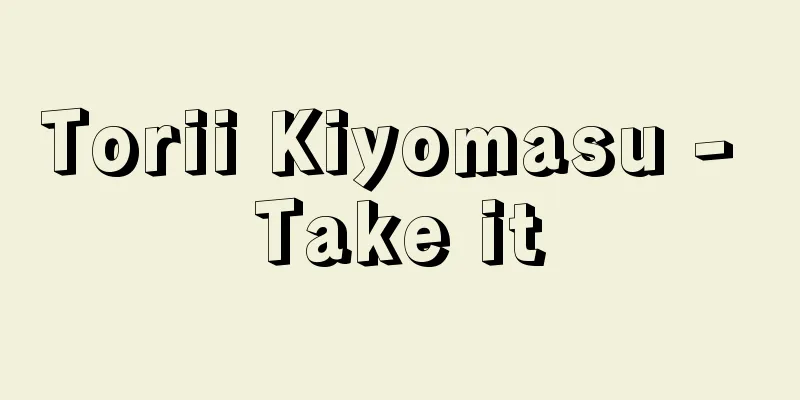Stone belt - Sekitai

|
A leather belt (kawaobi) decorated with jewels, stones, horns, etc., used for the formal attire of nobles (kuge) such as sokutai and the semi-formal cloth hakama (hoko). It is also called "ishi-obi" in Japanese reading. The name sokutai was given because it was worn with a robe (hou) and tied around the waist with a stone belt, and the stone belt is one of the important components of this costume. The belt is made of leather coated with black lacquer, and a fastening metal fitting called kako or mizuogane is attached to one end, and a leather tip metal fitting is attached to the other end. Several holes are made in key places in the leather, and the hook metal fittings are inserted through them to fasten them. In the morning attire prescribed in the clothing order of Yoro, it is called a yotai, and is decorated with gold and silver for those of the fifth rank or higher, and black oil for those of the sixth rank or lower. At the back of the waist, ornaments made of gold, silver, or blackened copper called "ka" are attached and lined up. The waist sash used by Emperor Shomu, a treasure of the Shosoin Repository, has a jasper bell, while the waist sash said to have been used by Sugawara no Michizane, handed down from Domyoji Tenmangu Shrine, has 15 bells in relief of silver and copper. In the mid-Heian period, the Japanese-style court dress came to be called sokutai, and the waist sash came to be called ishiobi. There were square and circular bells, the former called zunpo and used for ceremonies, and the latter called marutomo and used for everyday visits to the Imperial Palace. From the Middle Ages onwards, an obi with two junpo on each end and six marutomo lined up in the middle came to be called a tsuyo obi, and was used for both ceremonies and everyday wear. The best material for the sword was jade, followed by agate, rhinoceros horn, and rhinoceros horn (actually ox horn). Jade and agate could be decorated or undecorated. Those with decoration were used by nobles and above, and designs included round shapes such as phoenixes and cranes, demon shapes, lion shapes, and Chinese flowers in relief, while those with hair carvings were called kakushimon. The undecorated jade swords were used when the emperor wore silk clothing or festival clothing for Shinto rituals, round rhinoceros horn swords were used by courtiers in everyday life, and rhinoceros horn swords were used as heavy clothing, called juubuku, when dressed in heavy mourning, and always by those of the sixth rank or lower. In the late Kamakura period, for ease of putting on and taking off, the style was changed to retain only the part that touched the back of the waist, while the part that touched the stomach was omitted and tied with a string. In other words, a string was threaded through one end of the part that touched the back of the waist, called the hon-obi, and the remaining part that went around the back of the waist, called the uwate, to fasten them together, and separate strings attached to both ends of the hon-obi were wrapped around the stomach and tied. [Takada Yamato] [Reference] |Source: Shogakukan Encyclopedia Nipponica About Encyclopedia Nipponica Information | Legend |
|
公家(くげ)の正装である束帯や準正装の布袴(ほうこ)に用いられる玉、石、角(つの)などの飾りをつけた革帯(かわおび)。訓読して「いしのおび」ともいう。束帯は袍(ほう)を着て腰部を石帯で束ね締めるためにつけられた名称で、石帯はこの装束にとって重要な構成要素の一つである。革に黒漆を塗った帯の一端に鉸具(かこ)または水緒金(みずおがね)といわれる締め金具をつけ、他端に革先金(かわさきがね)をはめ、革の要所に数個の穴をあけて鉸具の刺金(さすが)を刺し通して留める。養老(ようろう)の衣服令に規定された朝服では腰帯(ようたい)といわれ、五位以上金銀装、六位以下烏油(くろつくり)としている。腰帯の後ろ腰にあたる部分に銙(か)という金や銀または黒塗りの銅の飾りを据え付けて並べることとなっている。 正倉院宝物の聖武(しょうむ)天皇使用腰帯には碧玉(へきぎょく)の銙がつけられ、道明寺天満宮伝来菅原道真(すがわらのみちざね)所用といわれる腰帯には、銀銅浮彫りの銙15個がつけられている。平安時代中期になって、和様化した朝服を束帯とよび、腰帯を石帯というようになった。銙の形に方形と円形とがあり、前者は巡方(ずんぽう)といわれて儀式に用い、後者は丸鞆(まるとも)といわれて平常の参内に用いた。中世以降、両端に巡方2個ずつと、中間に丸鞆6個を並べたものを通用帯とよんで、儀式と平常に兼ねて用いた。銙の材質は、玉を最高とし、瑪瑙(めのう)、犀角(さいかく)、烏(う)犀角(実際は牛角)などで、玉や瑪瑙には有文と無文があり、有文は公卿(くぎょう)以上が用い、文様は鳳凰(ほうおう)、鶴(つる)などの丸、鬼形、獅子(しし)形、唐花などを浮彫りとし、毛彫りしたものを陰文(かくしもん)とよんだ。無文で玉の巡方は天皇が神事に用いる帛御服(はくのぎょふく)または御祭服のとき、犀角の丸鞆は殿上人(てんじょうびと)が平常のとき、烏犀角は、重服(じゅうぶく)といって重い喪に服するときおよび六位以下の者がつねに用いた。 鎌倉時代後期には、着脱の便宜上、形式を変えて後ろ腰に当てる部分のみ古式を残し、腹に当てる部分は省略して紐(ひも)で結ぶようにした。すなわち、後ろ腰に当てる本帯といわれる部分と、上手(うわて)といわれる後ろ腰に回す締め余りの部分のそれぞれの一端に紐を通して相互を綴(と)じ付け、別に本帯の両端につけた紐を腹部に回して結び締めるようにした。 [高田倭男] [参照項目] |出典 小学館 日本大百科全書(ニッポニカ)日本大百科全書(ニッポニカ)について 情報 | 凡例 |
Recommend
Electric ray - Electric ray
A general term for a family or genus of the order...
Blame - Emergency
〘 noun 〙 A bad sign. A bad retribution. ※Edotoku N...
April Fools' Day
...It is said that exchanging the bush warblers d...
Obi repair - Obi naoshi
Same as "untying the obi". Source: About...
Arriaga, JCde - Arriaga
…In the second half of the 18th century, during t...
Fang Xiaoru - Fang Xiaoru
A Chinese thinker in the early Ming Dynasty. His ...
Lee De Forest
1873‐1961 American inventor. Also known as De Fore...
Dutch New Year - Dutch New Year
A gathering to celebrate the Western New Year, sta...
Aveling, E.
…Translated the work “History of the Paris Commun...
Otani
This is a district in the western part of Utsunom...
Oobuka - Oobuka
...It was named after the Sando-gasa, used by cou...
Euonymus moniliforme (transparent spot) - Euonymus moniliforme
A general term for insects belonging to the Ithomi...
manacine
...The flowers are small but numerous, solitary o...
Edo Inner Bay 44 Lakes Meeting - Edo Inner Bay 44 Lakes Meeting
In the Edo period, the headmen and representatives...
Inns of Court
In the UK, a private legal association that has th...









